

The Value of Movement outside a Studio
The Benefits of Movement in the Classroom. Efficiency in Learning The hippocampus needs time to process information because it is partially responsible for short-term memory and navigationAs students return to the content, the brain is able to refocusMovement helps to develop social skills, which are important for connecting to comprehension and critical thinking skillsRealigning the body/brain connection helps re-energize learning Stress Relief, Mood Elevation and Social Perks Class Cohesion.
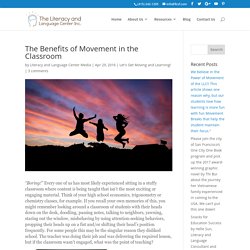
Movement in the Classroom – TEACH Magazine. Originally published in TEACH Magazine, May/June 2018 By Sean Blackmer After teaching at an alternative middle school for the past four years, the one thing I constantly hear from new students is, “we can move around in your room and not get in trouble?
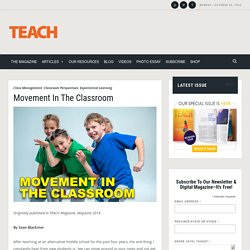
My old teacher never let me do this!” Why dance is just as important as math in school. Dance — and physical activity — should have the same status in schools as math, science and language.
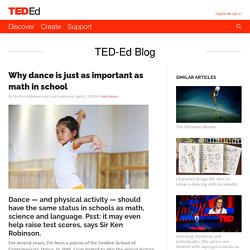
Psst: it may even help raise test scores, says Sir Ken Robinson. For several years, I’ve been a patron of the London School of Contemporary Dance. In 2016, I was invited to give the annual lecture in honor of founding principal Robert Cohan, and I decided to talk about the role of dance in schools. Movement and Learning. 5 Ways Movement Breaks in the Classroom Help With Behaviour. Teachers, how much physical activity do your students get every day?
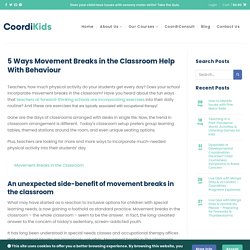
Does your school incorporate movement breaks in the classroom? Have you heard about the fun ways that teachers at forward-thinking schools are incorporating exercises into their daily routine? And these are exercises that are typically associated with occupational therapy! Gone are the days of classrooms arranged with desks in single file. Now, the trend in classroom arrangement is different. The brain-changing benefits of exercise. Is Movement Beneficial for Your Mental Health? - MINDBODY.
Are you ready to exercise your body and your mind?

Movement and brain health are inherently interconnected, and research suggests that physical exercise is just as beneficial for the brain as it is for the body. While the brain is the control center for the body, the body also directly impacts the functionality and health of the brain. Mind body connection not a one way street. Understanding the Mind-Body Connection. Reading Time: 5 minutes The mind and the body are not two separate entities—although they are often treated that way.
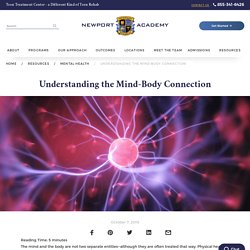
Physical health and emotional health are intimately intertwined in what’s known as the mind-body connection. Our chemistry and biology impact our mood and emotions, as well as thoughts and beliefs. With all of these factors combined, they play a major role in influencing our stress and physical health. If you’ve ever felt your stomach tighten up when you were anxious, you’ve experienced the mind-body connection. The Biochemistry of the Mind-Body Connection While we still don’t understand everything about the mind-body connection, scientists are discovering some of the ways in which communication occurs.
Communication happens via chemical and physical messengers, such as hormones and neurotransmitters. Stress and Physical Health: An Evidence-Based Link Studies have also determined that stressful emotions decrease immunity by altering blood cell function. Sources: Music and Movement at the Library. This past summer, the Fayetteville Free Library (FFL) offered several new early literacy programs targeted at improving family health and nutrition.
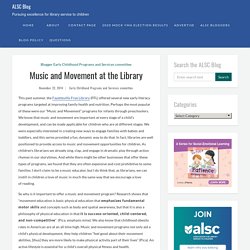
Perhaps the most popular of these were our “Music and Movement” programs for infants through preschoolers. We know that music and movement are important at every stage of a child’s development, and can be made applicable for children who are at different stages. We were especially interested in creating new ways to engage families with babies and toddlers, and this series provided a fun, dynamic way to do that. In fact, libraries are well positioned to provide access to music and movement opportunities for children.
As children’s librarians we already sing, clap, and engage in dramatic play through action rhymes in our storytimes. So why is it important to offer a music and movement program? Benefits to Movement Benefits of Music Music is vital to the development of language and listening skills. Program Plan (Photos courtesy guest blogger) Dancing Off the Page: Adding Movement to Storytime. Kinesthetic learners absorb information best when it’s combined with movement and action.
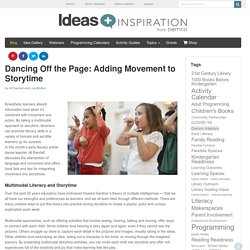
By taking a multimodal approach to storytime, librarians can promote literacy skills in a variety of formats and set little learners up for success.In this month’s early literacy article, dance teacher Jill Randall discusses the intersection of language and movement and offers book lists and tips for integrating movement into storytimes. Multimodal Literacy and Storytime Over the past 30 years educators have embraced Howard Gardner’s theory of multiple intelligences — that we all have our strengths and preferences as learners, and we all learn best through different methods. There are many creative ways to put this theory into practice during storytime to create a playful, joyful and curious exploration each week. Multimodal approaches, such as offering activities that involve seeing, hearing, talking and moving, offer ways to connect with each child. Three Principles for Intentional Movement in Storytime.
The word “intentionality” has taken on greater meaning within the world of library service to the very young in recent years, following the publication of Project VIEWS2 and Supercharged Storytimes: An Early Literacy Planning and Assessment Guide.[1] Storytime presenters are thinking more about how they want to support early literacy development through their programming in the materials they select and-more crucially—the way that they use those materials and engage with children and families throughout the storytime experience.

Another critical domain of school readiness, however, remains less well understood: physical development. Most storytimes in 2019 incorporate movement to some degree. However, that movement is typically used for the purpose of “getting the wiggles out” so that children are having fun and can become settled for the next reading or rhyming portion of the program. Automation. Cross-lateral Movement. Synergy. . [1] [2] [3] Earlychildhood NEWS - Article Reading Center. As a movement specialist for nearly a quarter of a century, I’ve seen response to my topic wax and wane over the years.
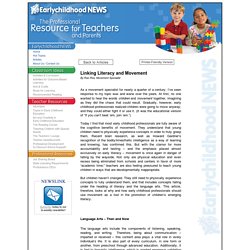
At first, no one wanted to hear the words children and movement together, imagining as they did the chaos that could result. Gradually, however, early childhood professionals realized children were going to move anyway; and they could either fight it or use it. (It was the educational version of “If you can’t beat ’em, join ’em.”) Today I find that most early childhood professionals are fully aware of the cognitive benefits of movement. Movement and Literacy. An Introduction to Dance/Movement Therapy. Dance/Movement Therapy. Dance/movement therapy is defined as "the psychotherapeutic use of movement as a process which furthers the emotional, cognitive, social, and physical integration of an individual " (ADTA).
The body is the central focus in the treatment process, and movement is the vehicle to express physical distress, feelings, and thoughts. The History of Dance/Movement Therapy The use of dance as a therapeutic modality is credited for former dance educator and performer Marian Chace. Dance / Movement Therapy. Dance/movement therapy, usually referred to simply as dance therapy or DMT, is a type of therapy that uses movement to help individuals achieve emotional, cognitive, physical, and social integration. Beneficial for both physical and mental health, dance therapy can be used for stress reduction, disease prevention, and mood management. In addition, DMT's physical component offers increased muscular strength, coordination, mobility, and decreased muscular tension. The Surprising Psychological Benefits of Dance Therapy.
When a group of psychologists from the U.K. visited Rwandan villagers to help heal genocidal trauma through talk therapy, the psychologists were soon after asked to leave. For Rwandan genocide survivors, rehashing their traumatic memories to a stranger while sitting in tiny rooms with no sunlight didn’t heal their wounds at all — it just poured salt on them, forcing them to relive the trauma over and over again. That wasn’t their idea of healing.
They were used to singing and dancing beneath the sun in sync to spirited drumming while surrounded by friends. That’s how they healed from trauma and other mental ailments.